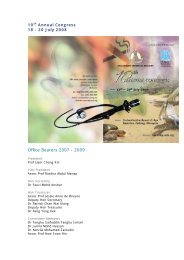download - Malaysian Thoracic Society
download - Malaysian Thoracic Society
download - Malaysian Thoracic Society
You also want an ePaper? Increase the reach of your titles
YUMPU automatically turns print PDFs into web optimized ePapers that Google loves.
Annual Congress of <strong>Malaysian</strong> <strong>Thoracic</strong> <strong>Society</strong><br />
PP 6<br />
Are tuberculosis treatment outcome categories missing something?<br />
A case report from Malaysia<br />
Atif M 1 , Sulaiman S A S 1 , Ali I 2 , Muttalif A R 3 , Shafie A A 1<br />
1<br />
University Sains Malaysia, Penang, Malaysia<br />
2<br />
Hospital Pulau Penang, Penang, Malaysia<br />
3<br />
Institute of Respiratory Medicine, Kuala Lumpur, Malaysia<br />
Objective<br />
This case report necessitates elaboration of World Health Organisation (WHO) recommended tuberculosis<br />
(TB) treatment outcome categories and points out rational use of antihistamines.<br />
Case description<br />
A 24 year university student with history of productive cough was registered as sputum smear positive case of<br />
pulmonary tuberculosis. During treatment, patient suffered from itchiness associated with anti-tuberculosis<br />
drugs, which was treated with chlorpheniramine (4mg) tablet. Patient missed 28 doses of anti-tuberculosis<br />
drugs in the continuation phase claiming that he was very busy in his studies and assignments. Upon<br />
questioning, he further explained that he was quite healthy after five months and unable to concentrate on his<br />
studies after taking he prescribed medicines. His treatment was stopped after six months, based on clinical<br />
improvement.<br />
Discussion<br />
Two major reasons, false perception of being completely cured and side effects associated with anti-TB drugs,<br />
might be responsible for non-adherence. Non-sedative antihistamines like fexofenadine, cetirizine or loratadine<br />
should be preferred over first generation antihistamines (chlorpheniramine) in patients with a lifestyle that<br />
requires concentration during the day. This patient had not completed the full course of chemotherapy, which<br />
is preliminary requirement for a case to be classified as “cured” or “treatment completed”. However, this<br />
patient had not defaulted for two consecutive months. Therefore, according to WHO outcome classification,<br />
this patient can neither be classified as “cured”, “treatment completed” nor as “defaulter”.<br />
Conclusion<br />
By applying WHO recommended “Patient Centered Approach”, we can reduce the risk of of non-adherence.<br />
A close friend, classmate or family member may be selected as a treatment supporter to ensure adherence<br />
to treatment. Antihistamines must be used rationally according to patient’s lifestyle. Further elaboration<br />
of WHO treatment outcome categories is required for appropriate classification of patients with similar<br />
characteristics.<br />
68








